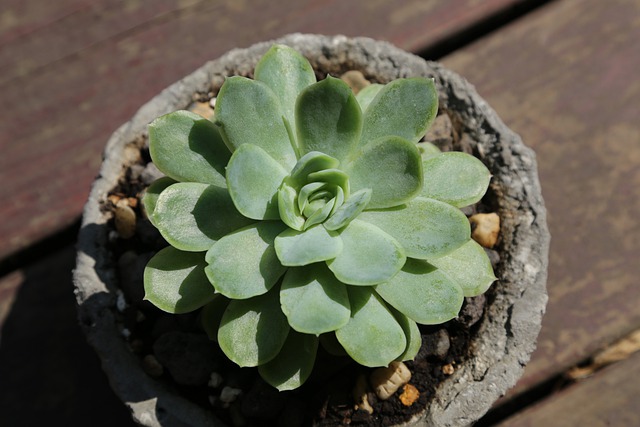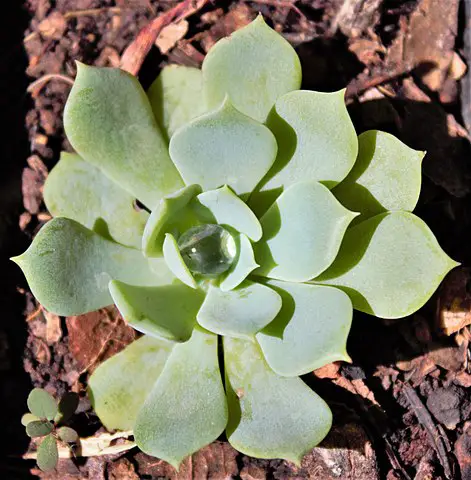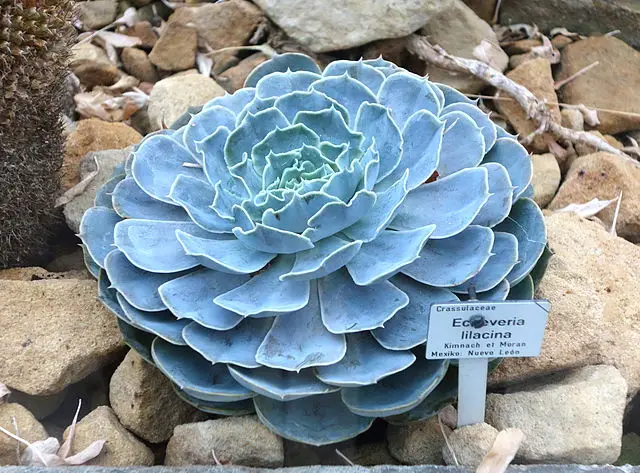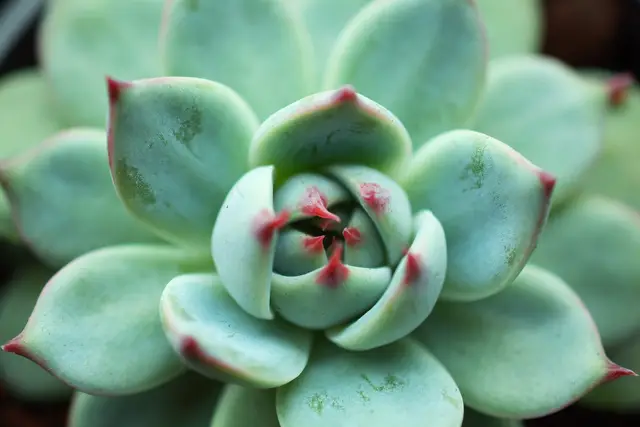Echeveria elegans is a small, rosette forming succulent originating from Mexico which grows attractive orange and yellow flowers on a long stem. Like all members of the Echeveria family, this is an easy to propagate plant, yet it nevertheless has specific requirements which must be taken into account. Want to know how to propagate these popular succulents? Read on for multiple methods of propagation as well as troubleshooting, tips, and optimal growing conditions.
In the wild, Mexican snowball reproduces by sending out offsets- smaller plants which are attached to the mother plant via stems which reach across the ground. Occasionally, in the right climactic conditions it will drop leaves which then grow roots and form plants of their own. Therefore, echeveria elegans can be propagated by two methods which mimic both of these processes – leaf cuttings and offsets. Mexican snowball is dormant in the winter so it is best to propagate it in summer for it to thrive. It also prefers full sun, therefore a spot such as a windowsill, greenhouse, or south facing patio (if you live in the northern hemisphere) is ideal.
Step by Step Propagation:
Stage One:
Before deciding to propagate, it is best to wait for the correct season (spring or summer, as stated above) as well as ensuring the correct temperature and conditions. Living in subtropical and semi-arid desert areas, echeveria elegans therefore prefer temperatures of between 10-21 degrees Celsius ( 50-70 degrees Fahrenheit) and a dry atmosphere, so for optimal growth ensure your echeveria does not receive too much humidity by keeping it away from sources of moisture such as bathrooms.
To begin leaf propagation, twist a leaf off the main plant, as this mimics the plant’s natural process of dropping leaves in the wild. When doing this, it is important to make sure the leaf has been entirely twisted off at the base and is not broken, as otherwise, it will not be able to grow new roots.
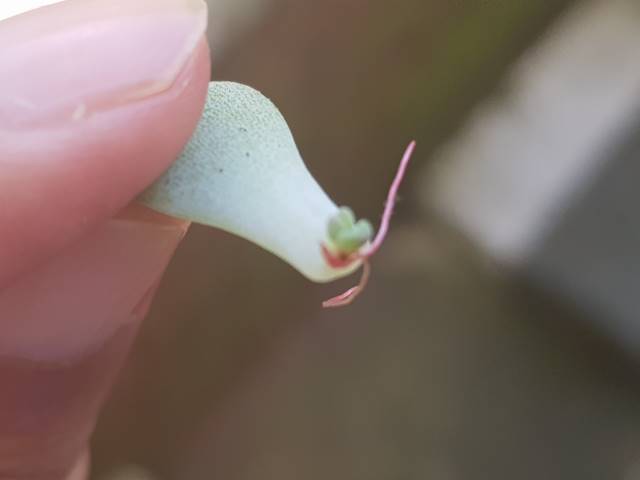
To choose a healthy leaf, ensure it is plump and isn’t withered. It’s best to pick one from the base of the stem as these are generally older and more robust. Discolored leaves – or leaves with pest marks – are also indicators that the propagation may not be successful. For the optimal chances of success, choose several in case of failure to propagate.
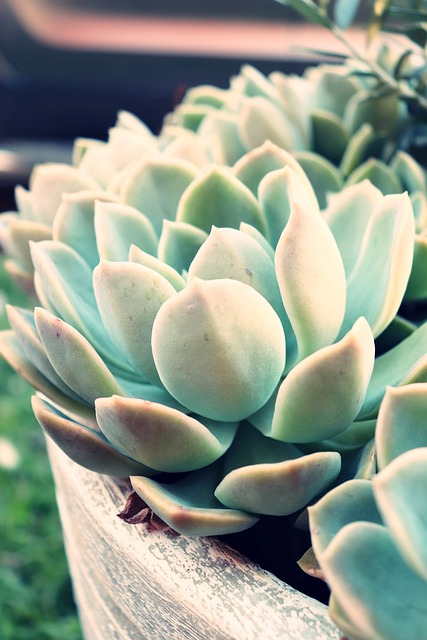
Once you have done this, place the leaf or leaves in your chosen spot on top of some soil, ideally sandy, quick draining soil like cactus soil or a mixture of sand and perlite. Alternatively you can spread them out on sheets of tissue paper or a kitchen towel. This stage involves waiting for the leaf to callous over at the base, at which point you will know it’s ready to grow roots.
Echeveria elegans Offset Propagation:
To propagate by offsets, cut the stalk between the offset and the mother plant and place the baby plant on suitable soil such as cactus soil or sand and perlite. The offset should take root by itself and once it has, it can be watered slightly more frequently than an adult plant would be – ideally as soon as each time the soil has dried out.
If propagating by the offset method, the process will be different. Mexican snowball plants do not grow offsets until they are two to three years old. Offset production is also dependent on their general health as an unhealthy plant will not have the energy to reproduce.
Stage Two:
If propagating by leaf, once the leaf has calloused over, it will take two to three weeks to put down roots. If you have left the leaf on paper, it can be transferred to soil once you see roots develop and a rosette beginning to form. Leaves can be given their own individual pots or laid on top of the soil in one larger pot, but if this is the case, they will need to be transferred to their own pots once rosettes have appeared.
At this stage, roots will make contact with the soil of their own accord and the baby plant will begin to grow. However, if you do have difficulty with this, dig a hole in the soil, gently press in the roots, and loosely pile the excavated soil around them.
Step Three:
During the stages of root growth, the mother leaf will wither as it provides its energy to the baby plant. It is best advised to avoid watering during this process as nothing is needed and in combination with the nutrients from the mother leaf, this may actually result in the plant being over-watered.
If propagating by offsets they will already have roots but must first be left to dry to avoid waterlogging. Echeverias root in a way which allows them to take advantage of rare yet intense periods of heavy rain, and are adapted to water which comes in large but sparse bursts and drains rapidly. It is sometimes advised to allow your echeveria’s leaves to dry slightly before watering, as this ensures it isn’t getting too much water. In the case of propagation, the mother leaf should have fully withered away before you water the offset, by which time it will have formed a miniature rosette in the same shape as the adult plant.
Echeveria elegans Natural Growth:
A third option is to allow the plant to propagate naturally. If planted in a suitable habitat such as a rockery, Mexican snowball will spread via it’s offsets and these will root independently, leaving the stem which attaches them to the mother plant to wither without it being cut. If conditions are right it can spread to a great extent, carpeting a large area and growing flower stalks up to one meter tall. In the plant’s adaption to survival in the desert, its roots spread far through the soil and will fill every available space. When allowing natural growth, your plant will need enough space for maximum root growth so like with leaf and offset propagation, choosing the right spot is necessary. Whichever way you choose to propagate, allowing the soil to dry also encourages strong root growth as roots spread in search of water.
Echeveria elegans Propagation Problems:
In the propagation process, you may come across difficulties but by understanding the plant’s habits these can be easily overcome. One major requirement for the Mexican snowball plant is high enough temperatures and during the propagation process, the plant will need extra energy- therefore
your propagation area must be sunny and enclosed. If the plant is slow to put down roots it may be because it does not have enough sunlight.
Mexican snowball is generally very easy to take care of and does not have many pests. That being said, vine weevils and mealybugs are occasionally a problem – mealybugs especially target subtropical plants such as most of the echeveria family. Due to its subtropical nature, Mexican snowball is also winter dormant and if deciding to grow it outside, it will need to be overwintered indoors unless you live in a tropical, desert, or subtropical climate. Therefore, before deciding to propagate in a permanent spot like a rockery, keep in mind whether you would be able to move the plant when the weather gets cold. Although echeverias can be grown outdoors, starting propagation indoors is best advised for both methods.
If your echeveria elegans is still not putting down roots, it may be time to consider cactus specific fertiliser – depending on the health of the mother plant, the time of year, and other conditions, some offsets are more tender than others.
Can You Grow Mexican Snowball from Seed?
Although not propagation in the true sense of the word, Mexican Snowball actually can be grown from seed by collecting seeds from the flower spikes after the flowers have died. Echeveria elegans seeds are very small, and can be mistaken for dust, so to collect, hold a tissue under the flower spikes and shake it, then transfer the resulting dust to your chosen soil and cover it gently with a thin layer.

The seeds take two to three weeks to germinate providing they are in suitable conditions – at this stage they will need more watering than the adult plant and should not be allowed to dry out. Once you see sprouts, you can continue watering at the same rate until they can withstand the soil drying without withering.
In conclusion, echeverias are one of the easier families of succulent to propagate, but they still have specific care needs. The popularity of succulents and growing trend for them means many myths have circulated about certain species ‘thriving on neglect’ – which in reality does not fully encompass the requirements of propagation. For a first time succulent grower, it is best to take into account that not every offset is successful and sometimes this can be out of your control. Nevertheless, echeveria elegans is a fun and attractive plant to propagate and a good way to begin building skills in propagation.

